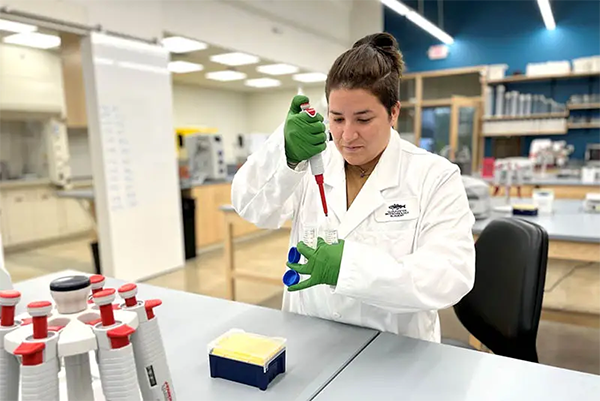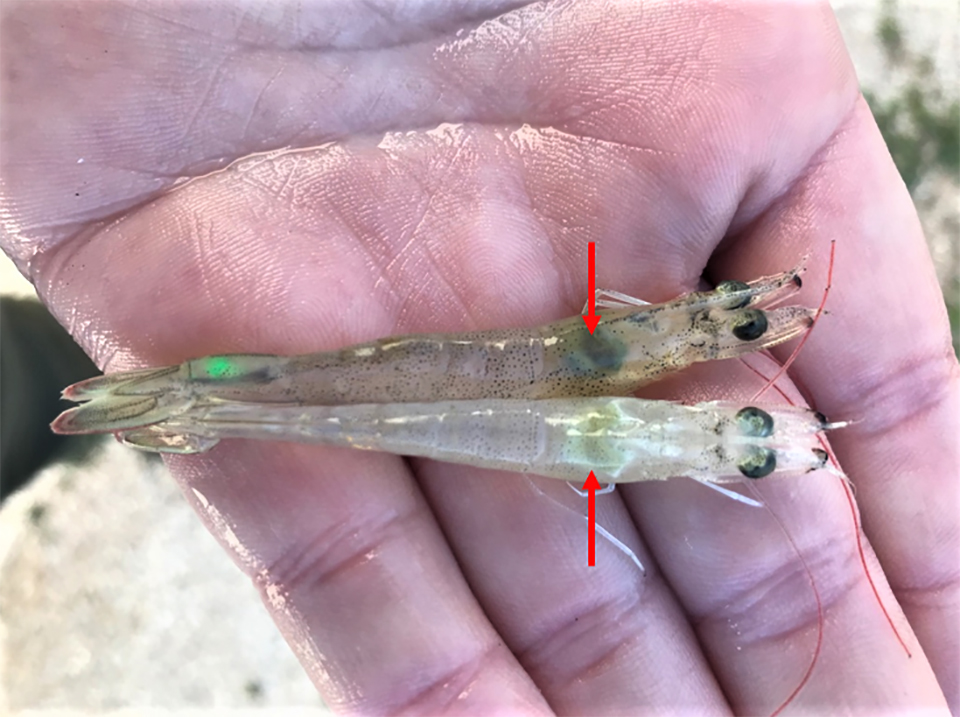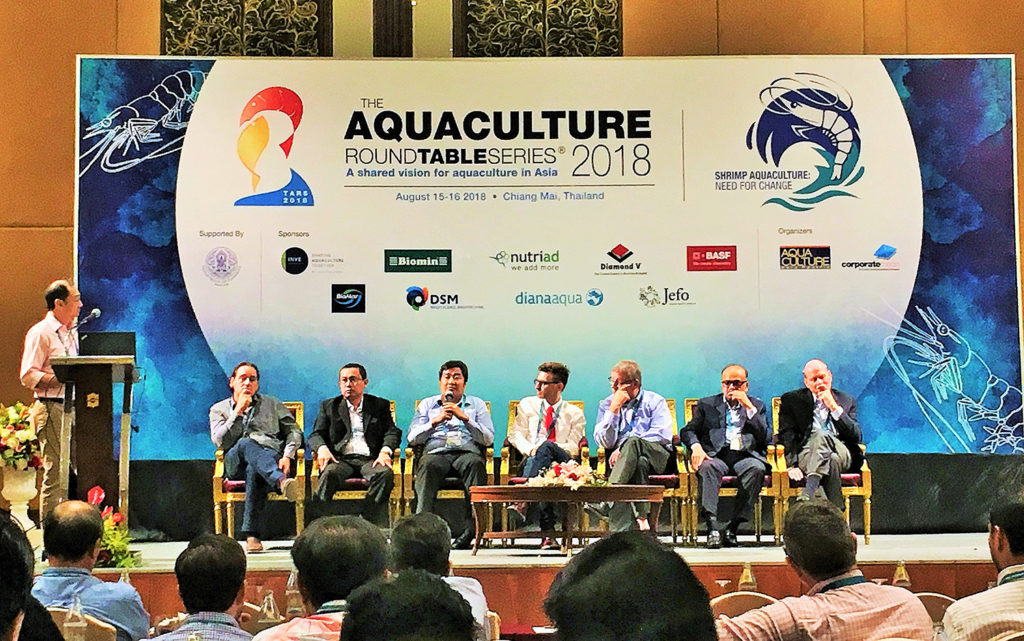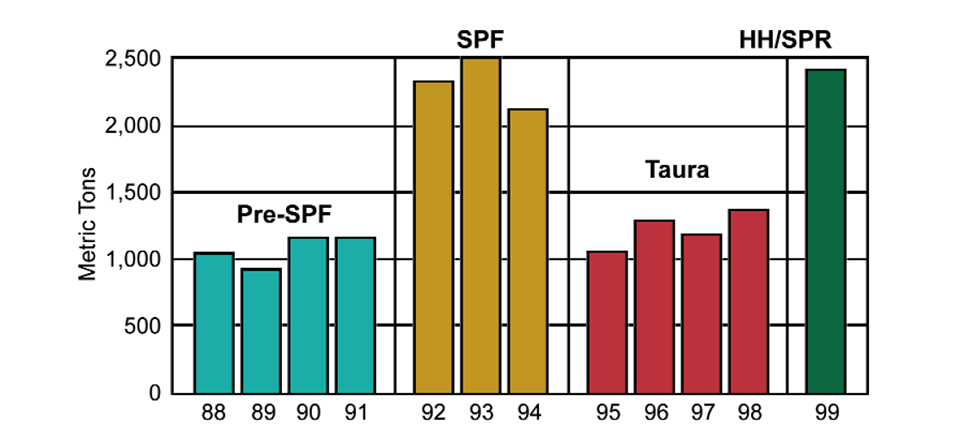Funding fast-tracks the commercialization of a gene-sequence technology that detects shrimp diseases in the field quickly and cost-effectively

Infectious diseases can crater aquaculture output, saddling producers with significant economic losses. White Spot Syndrome Virus (WSSV), for example, is so deadly to Pacific white shrimp that an outbreak can cause close to 100 percent mortality in as little as a week. Over the last 30 years, losses due to the virus have topped an estimated $15 billion.
Given the speed with which the disease spreads and its lethality, shrimp farmers need tools to rapidly identify an outbreak so that measures can be taken to contain and treat the virus. Sherlock Biosciences is now partnering with the Gloucester Marine Genomics Institute (GMGI) to develop a diagnostic tool through a U.S. Department of Agriculture (USDA) Small Business Innovation Research (SBIR) Phase I award. The objective is to alert producers to a problem before it becomes a catastrophe.
“The ultimate goal is to sell directly to shrimp farmers, who currently have to send their samples to central laboratories, delaying the time for diagnosis and impacting the ability to quickly respond to outbreaks. With our platform, they can get the information they need within 30 minutes,” Mary Wilson, director of assay research at Sherlock Biosciences, told the Advocate.
This new tool builds upon research done by GMGI for years in developing a test for WSSV, according to Andrea Bodnar, science director. Those efforts succeeded, producing a sensitive test that could spot trace amounts of the virus. Bodnar noted that the researchers used tools originally developed to do gene editing, a technology called CRISPR.
“We’re using that same technology to detect specific genetic sequences,” she said.
These sequences uniquely identify WSSV, while CRISPR technology releases only those specific genetic sequences, leaving everything else alone. Amplification of those snippets multiplies them and turns minute amounts of tell-tale genetic sequences into enough material to be detected.

The technique developed and demonstrated by GMGI used a fluorescent marker, a tag molecule attached to create a visible glow when a sample containing the virus was illuminated with the right light. This approach gave results comparable to the laboratory-based gold standard for detecting the virus, a quantitative polymerase chain reaction, or qPCR test. However, the GMGI test required further refinement to make it deployable in the field.
That’s where Sherlock Biosciences came in. The company’s initial focus has been on diagnosing human diseases, Wilson stated. In these efforts, Sherlock Biosciences has worked to simplify sample preparation so that its diagnostics can be used by untrained operators while maintaining sensitivity to react to small amounts of the pathogen. The other goal has been to have a test that is specific to a given disease, thereby minimizing the chance for a false reading.
Test characteristics such as speed, sensitivity, specificity and low cost are attractive in diagnosing human diseases. Those same attributes are also useful when spotting animal diseases.
“When it comes down to it, we believe nucleic acids are nucleic acids, no matter the source material,” Wilson said. “Our chemistries are very good at releasing and detecting nucleic acids in clinical samples.”
In an October statement, Sherlock Biosciences and GMGI reported significant progress in converting the GMGI method to run on a Sherlock Biosciences platform.
After demonstrating that the diagnostic works, the next step will be akin to a beta test, with many different samples. The viral load in these samples will be evaluated by the new tool in a field deployment, with results compared to those from the qPCR method run in a lab. This beta test phase could take place next year, with the timing depending on funding and other factors. The length of the beta test, which will be paid for through an SBIR Phase II grant, has not yet been publicly announced. Product rollout could begin after the successful completion of the beta test.
The cost of the testing has not been set but estimates by Sherlock Biosciences are that diagnostics could be done for U.S. $5 to $20 each. That is significantly less than the cost to run qPCR. The new test results will also be available in minutes, not days.
While Sherlock Biosciences and its initial work with GMGI is focused on WSSV, Wilson noted that the company’s platform doesn’t care about the upstream organism whose genetic sequences are detected. Thus, many other diseases of interest could be tested.
“We believe the platform can be expanded to other diseases of interest to aquaculture,” Wilson said. “We imagine a future where, rather than sending samples out for testing, farmers are able to test their stocks for a panel of diseases on our platform.”
Now that you've reached the end of the article ...
… please consider supporting GSA’s mission to advance responsible seafood practices through education, advocacy and third-party assurances. The Advocate aims to document the evolution of responsible seafood practices and share the expansive knowledge of our vast network of contributors.
By becoming a Global Seafood Alliance member, you’re ensuring that all of the pre-competitive work we do through member benefits, resources and events can continue. Individual membership costs just $50 a year.
Not a GSA member? Join us.
Author
-

Hank Hogan
Hank Hogan is a freelance writer based in California who covers science and technology. His work has appeared in publications ranging from Boy’s Life to New Scientist.
Tagged With
Related Posts

Health & Welfare
AHPND is a chronic disease in Pacific white shrimp from Latin America
There is a new phase of infection for Acute Hepatopancreatic Necrosis Disease on Latin American shrimp farms, a contrast to observations in Southeast Asia.

Intelligence
At Aquaculture Roundtable Series, talk of change for Thai shrimp
The theme of the Aquaculture Roundtable Series in Chiang Mai was “Need For Change.” That means innovations in all production phases of Thai shrimp.

Health & Welfare
Breeding shrimp for fast growth and virus resistance
Recent successes have proven that breeding shrimp for fast growth and virus resistance is both feasible and highly effective.

Health & Welfare
Estimating heritability of WSSV resistance in Pacific white shrimp
A study in Vietnam showed that there was significant variation in WSSV resistance among Pacific white shrimp families evaluated.


